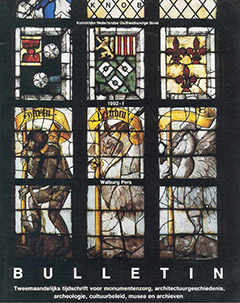Indexering ESCI / Scopus


Thomas H. von der Dunk: Wat er staat is zelden Waterstaat; Overheidsbemoeienis bij de vormgeving van katholieke kerkgebouwen in Gelderland in het tweede kwart van de negentiende eeuw. Victor M. Schmidt: Deugdzaamheid voor de buitenwacht: de gevel van het huis Cardinaal te Groningen. H. Janse: Een Nederlands gebrandschilderd glas in de Heilig Bloedkerk te Wilsnack. Dirk J. de Vries: Monumenten dendrochronologisch gedateerd (4).
For a long time the name ‘Churches of Public Works’ was automatically given to the neoclassical Churches from the second quarter of the 19th century, which went up under the supervision (and partly after the plans) of engineers of the department of Public Works. The construction of these churches was State-aided. This name concerned simple brick hall churches without columns with a white-plastered interior and a peristyle or pilaster facade on the front, crowned with an elegant cupola-tower. Research in the Dutch province of Guelderland however proved that examples of the churches as...
Cardinaal House in Groningen is well-known to specialists of Netherlandish Renaissance architecture (note 1), but the sculptured decoration of the facade, which is dated 1559, has never been treated at any length. Thanks to new archival material the original owner of the house could be identified, which made it possible to discuss the facade as an expression of his status and cultural ideals.
The facade of Cardinaal House (so called after its last owner, Mr. Klaas Cardinaal) is not in its original location any more. The house was demolished in 1893, but the facade was taken apart...
Although in the Netherlands medieval stained glass windows only have been preserved fragmentarily sources like the accounts of the Lords of Voorne prove that the Dutch art of glass painting was very prosperous already in the beginning of the 15th century.
The window Lord Frank van Borselen in 1460 gave to the H. Blood Church at Wilsnack (Brandenburg) had ninety-four panels of which eighty were painted. The miracle of the H. Blood would have taken place in 1383. Three consecrated wafers on the altar of the Church of St. Nicholas came to no harm of the fire, which completely burnt...
Within a period of about one year the State Service for the Preservation of Monuments has collected 265 wood-samples. About half of these could be dated. To enlarge the chance of dating different samples have been taken per construction- phase. The chance for dating also proved to be dependent of the place the wood was chopped and employed afterwards. Pending restorations well-worn materials often are removed, which spoiled the chance for dendrochronological dating.
Information on the working process, marks etc., gets lost as well. Therefore the State Service for the Preservation...


open access mogelijk gemaakt door Stichting OpenAccess
